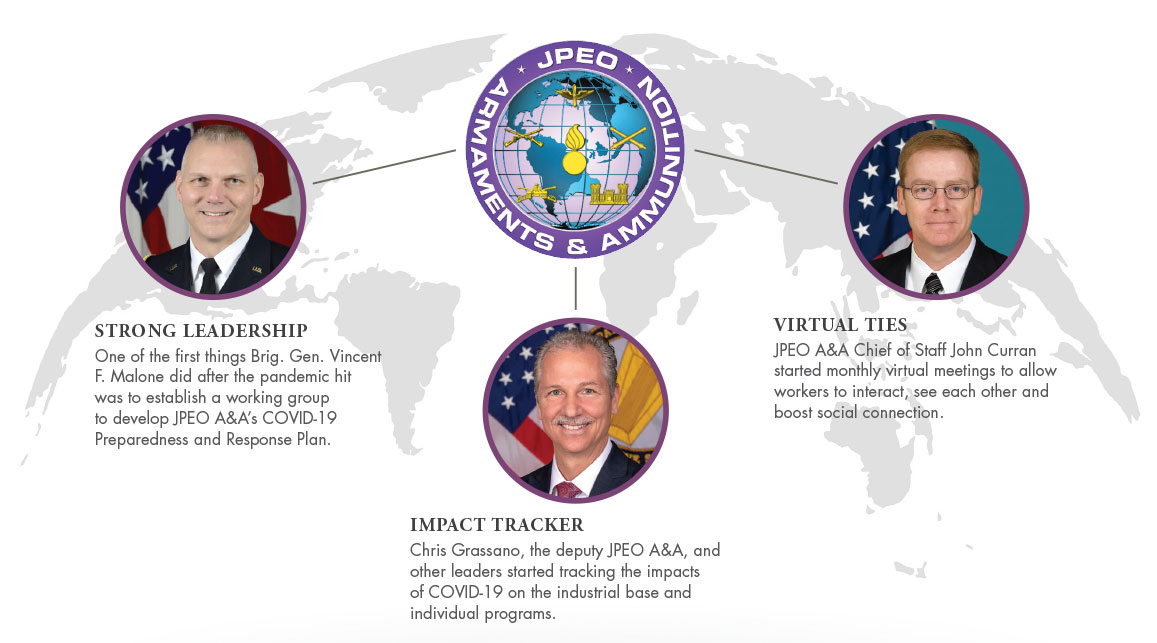
PEACE OF MIND: Teleworking gave many of us peace of mind, knowing we could continue to work while minimizing possible exposure to the coronavirus. (Image by Getty Images)
The COVID-19 pandemic has forced the Army and nation to fast-forward
to innovation, but will the remarkable changes last?
by Dr. Bonnie Berdej

DR. BOZENA “BONNIE” BERDEJ
Last March, when COVID-19 hit hard and telework became the new norm, Army leaders wondered if it would work. Secretary of the Army Ryan D. McCarthy said, “The rapid spread of COVID-19 across the globe has spurred many internal discussions concerning the Army’s future operating budget.” He added that “nothing has had the contagion and the proliferation like we have seen with COVID-19 since the Spanish flu of 1918.” Gen. James McConville, the Army chief of staff, emphasized that “COVID-19 has impacted everything we do, but we still have to protect the nation.”
The “new normal” had begun, but not without a period of turbulence before things could settle down. Army organizations adapted new procedures to successfully navigate and overcome the unknown. Response plans likely became the No. 1 discussion topic among Army leaders. Soon after, Army leaders realized that the COVID crisis was an opportunity to review the existing strategies and to change the way we do business. In doing so, they identified strengths and weaknesses, and developed effective contingencies as part of future business plans. At the Joint Program Executive Office for Armaments and Ammunition (JPEO A&A), Brig. Gen. Vincent F. Malone established a working group to develop the JPEO’s COVID-19 Preparedness and Response Plan.
“Our working group,” Malone wrote, “will continue to refine this document as we develop and implement control measures to minimize the risk of exposure in the workplace. As the Army transitions to operate in a COVID-19 environment, your safety remains our highest priority!” Malone committed himself to provide weekly updates “as we refine our plans for safe operations in a COVID-19 environment.”
WHAT DID THE ARMY DO GREAT?
I want to focus on three positive outcomes that resulted from this global pandemic and benefited the Army Acquisition Workforce. Despite the challenging environment, there were considerable opportunities for Army organizations. One such opportunity was to construct flexible procedures including telework and virtual measures. Granted, originally there was no other choice but to telework. As time passed, though, leaders realized that efficiency and effectiveness increased. This was because of several contributing factors. First, for those who could telework, their commute was eliminated and with that their traffic frustrations. Did it affect our work input before? My former commute was about 25 minutes, but now and then an accident or an unexplained backup at the gate would double that. Sometimes more. I’d get into the office frustrated and needing to catch up. That hasn’t happened now in most of a year.
Our workdays changed. The workday was no longer constrained solely by hours. Instead, while we have to work our regular hours, we can base our approach more on task completion. While this may be good or bad or both, it allowed for greater flexibility when managing tasks. It also reduced stress related to falling behind schedule and coming home late from work. There is also a benefit in reducing commuter-related expenses. We like to save money. For me, elimination of this expense and other aforementioned stressors resulted in greater inner peace and improved efficiency.
SELF-IMPROVEMENT BY TELEWORK
One of the studies I analyzed for my doctoral research, “Emotional intelligence. A catalyst for inspirational leadership and management excellence,” by Parvesh K. Chopra and Gopal K. Kanji, delivered evidence that emotional intelligence is responsible for managing stress through logic, reasoning, planning, learning and thinking. It was likely to improve problem-solving and increase the desire to get involved in organizational objectives. According to the authors, reduction in the level of stress may be linked to increased emotional intelligence, which “has immense significance and relevance for self-emotional management, development of human potential, relationship management at home and work, teamwork … job performance, organizational development, creativity and innovation.”
Perhaps the most important benefit of teleworking was the peace of mind many of us had in knowing that we could continue to work and minimize the exposure to COVID-19 at the same time.
Dr. Jarrod Sadulski, faculty member in criminal justice at the American Military University, in West Virginia, works with service members and can shed some light on the importance of reducing COVID-related risks. In an article, “Coronavirus: Advice on Teleworking for Servicemembers,” he wrote that “by reducing the need to leave home, teleworking enables servicemembers to limit contact with others, thereby slowing the spread of the coronavirus pandemic. In addition to protecting servicemembers and their families, teleworking protects an entire military unit and its workforce,” which directly affected the production rate and increased effectiveness.
When Army leaders realized the benefits of teleworking, they made an informed and educated decision to continue with measures that assure everyone’s safety and prevent the mission from failing—a decision that counterbalanced the virus effectively and successfully. While COVID has no respect for gender or age, Army leaders have shown increased respect for human dignity and safety by implementing strategies that calm emotions and eliminated anxieties associated with depression and poor mental health.

NEW APPRECIATION: Not all of COVID-19’s impacts were negative. Teleworking from home gave us a new appreciation for one another and for our families, and a realization for how much we need each other. (Image by Getty Images)
RESILIENCE AND STRENGTH
The second great positive was that, in this new environment, creativity kicked in. Army leaders partnered with industry to ensure their organizational health and continuity. I found it fascinating how social we are. We can create a future just by talking about it. People meet and come up with a concept and then make it happen. “Our mission of delivering materiel capabilities to the warfighter is accomplished by the total force, including military, civilian and defense industrial base partners,” said Dr. Bruce D. Jette, the assistant secretary of the Army for acquisition, logistics and technology and the Army acquisition executive. Keeping defense companies healthy and well-functioning is critical to achieve our mission. To that extent, Dr. Jette made it clear that “the resiliency and strength of our team is a national asset and is critical to our Army’s ability to meet mission requirements around the world. We must do what we can to support it.”
At JPEO A&A, leaders including Malone, Chris Grassano, the deputy joint program executive officer, and JPEO A&A Chief of Staff John Curran and many others, did exactly that. They started tracking the COVID industrial base and programmatic impacts on a weekly basis to ensure proactivity and support for our industry partners. Throughout this process, we have seen temporary closures resulting from state directions, loss of non-government income, COVID cases in manufacturing buildings, test delays because of travel restrictions, 20 to 30 percent absentee rates in some companies, and reduced production. The government teams closely monitored these risks. JPEO A&A teams worked with industry partners to develop response plans and address existing issues. Midway through the year, we started seeing more potential COVID issues resolved. The rate of success was definitely increasing.
COMMITTED EMPLOYEES
Malone leads JPEO A&A with business in mind. In one of his message to the JPEO A&A workforce, he emphasized the importance of tracking these impacts and effectively addressing them so we can ensure continued delivery to the warfighter. Malone provided strategic direction and built appropriate organizational infrastructure to guarantee success. At JPEO A&A we have witnessed not only leadership at its best, but also leadership marked by high emotional intelligence that resulted in increased motivation, production, effectiveness and great teamwork. In an article from Organizational Dynamics in 1985, “Leadership: Good, better, best,” Bernard M. Bass talked about leaders who challenge the status quo to improve organizational effectiveness. Similarly, in his 1993 article “Transformational Leadership and Organizational Culture,” Bass emphasizes that such leaders “align others around the vision and empower others to take greater responsibility for achieving the vision … they foster a culture of creative change and growth … they take personal responsibility for the development of their followers.”
I believe that our leaders challenged everything about the situation we found ourselves in, but they did it in a way that pulled everyone together, not by force but by commitment.
Ivan T. Robertson and Cary Cooper, in their 2011 book, “Well-Being: Productivity and Happiness at Work,” demonstrate that such employee commitment was associated with three elements: work-life balance, well-being, and work values that in recent years have become mainstream affecting organizational effectiveness. It was a volunteering effort to support the organization and improve the outcomes. Had we had less capable leaders during these unprecedented times, we probably would be seeing increased numbers in organizational discontinuity. When leaders do not act quickly and effectively, companies are likely not to survive sudden crises. Richard Foster and Sarah Kaplan, in their 2001 book titled “Creative Destruction,” said that organizational discontinuity happens when companies lose control of present operations during unprecedented waves of creative destruction, while losing their presence in the market. COVID-19 certainly was unprecedented and silently destroyed many companies.
Would it have made a difference if we’d had a warning? I believe that we had a warning, but the pandemic would still run its course, forcing waves of creative destruction on organizations across the country. At the end, emotionally intelligent leaders pulled through.

MENTAL HYGIENE
Finally, “code-switching” became an important part of the adjustment. We went from jackets and ties to polo shirts in our virtual meetings with leaders. Being with the family also took on a new meaning last year. For many, COVID-19 gave us a new appreciation for one another and for our families. We realized how much we need each other. At JPEO A&A, leaders took on initiatives to implement virtual get-togethers, monthly virtual town halls, and value-added trainings and programs.
There is implicit sympathy we share with no words required. That sympathy needs to be nurtured to produce organizational and personal fruits. Michael L. and Katherine P. Stallard in their 2020 Government Executive article, “COVID-19 Is Coinciding With a Loneliness Epidemic,” stressed that “collectively, we understand the goodness of ‘flattening the curve.’ Each of us must do our part to slow the spread of the virus and COVID-19, the disease it causes. But it is not the only epidemic we are facing right now. The requirement to separate ourselves from others comes at a time when America and many other nations are in the midst of an epidemic of loneliness whose antidote is greater positive social connection.”
To combat this new sub-enemy, leaders such as the JPEO A&A’s Curran, the chief of staff, implemented monthly virtual meetings to give us the opportunity to interact, see each other, and boost social connection. This was significant because stressors such as social distancing increased vulnerability to other stressors, e.g., loneliness. By having these monthly town halls and communicating the current situation to the workforce, leaders boosted positive emotions and willpower. The long-term effects of such initiatives could possibly be responsible for an even more reduced depression rate.
A study published in The Lancet last March, “The psychological impact of quarantine and how to reduce it: rapid review of evidence,” delivered evidence showing that quarantined individuals experienced irritability, insomnia, poor concentration, deteriorating work performance and reduced work concentration. The authors, Samantha K. Brooks, Ph.D., Rebecca K Webster, Ph.D., Louise E Smith, Ph.D., Lisa Woodland, Simon Wessely, Neil Greenberg, and Gideon James Rubin, found that isolated individuals “reported sufficient symptoms to warrant a diagnosis of a trauma-related mental health disorder.” Imagine if our leaders did not react the way they did.
Army leaders developed trainings to address feelings of isolation. Billy Hallmark, the Army substance abuse and suicide prevention programs manager at Detroit Arsenal, said, “Training constantly needs to change to meet the needs of the current situation. … Due to the impact of COVID-19, racial tension, job loss, grief, isolation, political tension, and the unpredictability of life increases stress and depression and needs to be addressed.”
Dr. Holly O’Reilly, a clinical psychologist at the Defense Health Agency, said that “sometimes a little bit of help is all we need to improve our mental health and be mission ready; taking small steps to address problems early on makes a big difference, especially during the pandemic.” So, our leaders did exactly that, they took small steps to address potentially gigantic problems.
HOW DO WE KEEP THESE GAINS?
Critical to success was that leaders applied the “soft skills” to battle the “tough” enemy. Life as we know it suddenly stopped. All of those who could stay home or were forced to stay home still are home. In a matter of days, we were taken out of our busy lives and told to deal with the new normal. It would be intellectually implausible to think that this new reality hasn’t taught us anything. Surely it must be giving all of us a new perspective and encouragement to reprioritize the hierarchy of importance.
So, what became really important? I think people did. Given the current environment and its impact on all operations, people remain the first priority. “Winning matters, and people are my No. 1 priority,” said Gen. James McConville, 40th chief of staff of the Army. “People are our Soldiers—regular Army, National Guard and Reserve—their families, civilians, and Soldiers for life—retirees and veterans. We win through our people, and people will drive success in our readiness, modernization and reform priorities. We must take care of our people.”
Leadership matters. It is the people who keep the Army’s strategic approach to modernization strong and priorities on track, but it takes leaders who lead to maintain a healthy and motivated workforce. We generated our strength at home and our self-worth at work. Leaders provided a sense of direction. Their soft skills continue to prove to be indispensable in challenging times. There is a clear correlation between leaders’ emotional intelligence and the performance of their organization. These skills operate in both verbal and non-verbal areas responsible for emotional sensitivity and expressiveness.
HAVE WE CROSSED THE RUBICON AS A NATION?
COVID-related challenges required a lens that looks beyond what we understand, and focuses on factors that affected behaviors. Paul Sparrow and Carry Cooper, in their 2014 article, “Organizational effectiveness, people, and performance: new challenges, new research agendas,” remind us that unlike in the 1950s, when organizations focused on a system model as a determinant of organizational effectiveness, modern organizations attribute this responsibility to leaders. This is because leadership matters. We look to leaders for guidance and example. We hope they can create that internal or external customer perception, which makes all of us appear strong and ready to deliver regardless of the enemy we face. We know there is more to performance than the interplay among productivity, flexibility and profit. And to that extent, I was glad to see our leaders making effective consequential decisions quickly and under intense pressure, often with incomplete information.
The environment we have found ourselves in triggers both positive and negative emotions. Some of us might have even experienced cognitive dissonance while attempting to discern everything 2020 had to offer. We continue to search for our COVID-19 identity. As we filter through the news reports and other sources of information, we wonder how we fit in. It is likely that this question remains unanswered for many. The line between truth and lies is as cloudy as it was in March 2020. It seems that creative destruction is at its best with one small exception: COVID-19 went straight for destruction, putting creativity aside, but leaders fought to bring it back.
For more information, contact the author at bozena.berdej.civ@mail.mil.
NOTE: This article is based on the author’s approved doctoral research. Her dissertation, “Leader emotional intelligence as a response to creative destruction and its effects on organizational effectiveness,” closely reflects her people-centered leadership values. The author strongly believes that one cannot become an effective leader without having the desire to grow others. Therefore, the concept of emotional intelligence is, in her view, a critical element in effective leadership. Her extensive research delivers evidence that empathy and social skills are two indispensable facets of emotional intelligence required for building effective organizations.
BOZENA “BONNIE” BERDEJ serves as the acting acquisition manager supporting the headquarters acquisition team at JPEO A&A, Picatinny Arsenal, New Jersey. She began her government career there in 2009 as a procurement analyst in the Office of the Project Manager for Close Combat Systems, advancing to become the senior business management specialist in the Office of the Project Manager for Conventional Ammunition Systems, before assuming her current responsibilities. She holds a doctoral degree in management from University of Maryland University College. A member of the Army Acquisition Corps since 2012, she is DAWIA certified Level III in program management and Level I in business – financial management, and is certified Level III in security cooperation by the Defense Institute of Security Assistance Management. She also holds Black Belt Six Sigma certification.
Read the full article in the Winter 2021 issue of Army AL&T magazine.
Subscribe to Army AL&T – the premier source of Army acquisition news and information.
![]()







